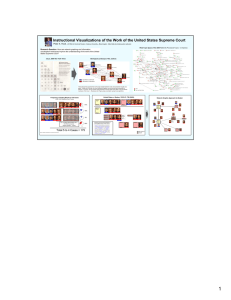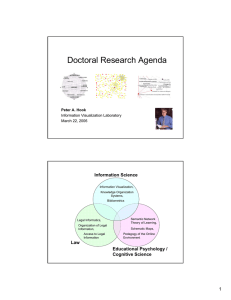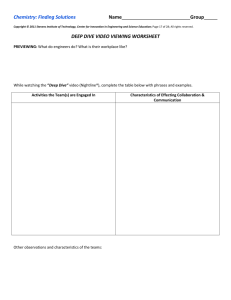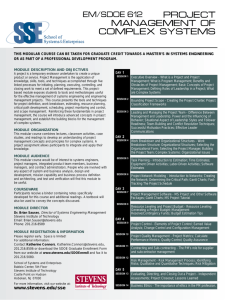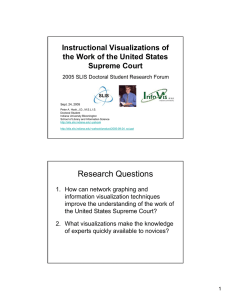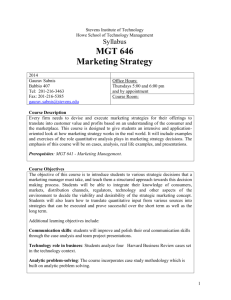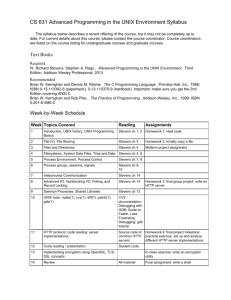Network Derived Educational Visualizations SLIS Peter A. Hook
advertisement
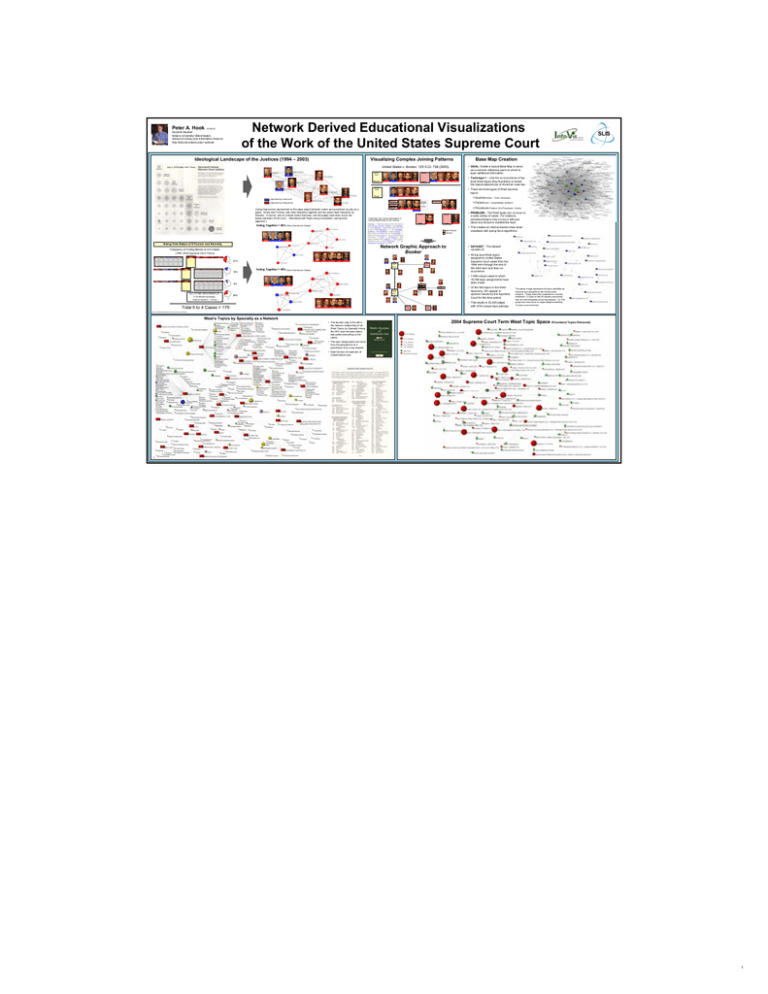
Peter A. Hook Network Derived Educational Visualizations of the Work of the United States Supreme Court , JD MSLIS Doctoral Student Indiana University--Bloomington School of Library and Information Science http://ella.slis.indiana.edu/~pahook Ideological Landscape of the Justices (1994 – 2003) Visualizing Complex Joining Patterns United States v. Booker, 125 S.Ct. 738 (2005). July 2, 2005 New York Times Opinion: Part 1 • Technique 1 – Use the co-occurrence of top level West topics (Key Numbers) to render the topical adjacencies of American case law. Breyer Opinion: Part 2 • There are three types of West top level topics: Breyer Doctrinal (blue – Torts, Contracts) Stevens I Appointed by a Republican Except Footnote 17, Part IV Stevens II Voting frequencies represented as the edge weight between nodes and presented visually as a graph. Scalia and Thomas vote most frequently together and are joined least frequently by Stevens. O’connor, and to a lesser extent Kennedy, are the judges most likely to join the liberal members of the Court. (Rendered with Pajek using a stochastic, spring force algorithm.) Stevens IV Stevens III Factual (red – Automobiles, Aviation) Procedural (Federal Civil Procedure, Courts) Dissent Dissent Scalia Thomas • PROBLEM – The three types can co-occur in a wide variety of cases. For instance, procedural topics may co-occur with just about any factual or substantive topic. Customary, Non-Visual, Explanation of Joining Relationships of the Justices Voting Together > 50% (Non-Unanimous Cases) Main Opinion Dissent Swing Vote Status of O’Connor and Kennedy Network Graphic Approach to Booker Frequency of Voting Blocks in 5-4 Cases (1994 -2003 Supreme Court Terms) 82 47% Dissent Opinion : Part 1 175 Breyer Stevens 28 16% Voting Together > 49% (Non-Unanimous Cases) 14 8% • DATASET - The dataset consists of: • All top level West topics assigned to United States Supreme Court cases from the 1944 term through the end of the 2004 term and their cooccurrence. Stevens I Stevens II (Highest repetition – 3 times) • This creates an interconnected mess when visualized with spring force algorithms. • 7,948 unique cases to which 19,789 topic assignments have been made. 175 175 ALL OTHER GROUPINGS OF 5 (34 different groupings) Base Map Creation • GOAL: Create a topical Base Map to serve as a common reference point on which to layer additional information Dissent Stevens Appointed by a Democrat SLIS Stevens III Stevens IV Opinion : Part 2 51 Except Footnote 17, Part IV Breyer 29% 175 Total 5 to 4 Cases = 175 Dissent Dissent Scalia Thomas • Of the 405 topics in the West taxonomy, 291 appear in opinions issued by the Supreme Court for this time period. • This results in 22,345 edges with 3743 unique topic pairings. The above image represents all topics identified as doctrinal and assigned to law School class subjects. These were then subjected to a double treatment. (1) Each of the 55 classes was paired with its most frequently occurring subjects. (2) The graph was reduced to an edge weight exceeding 10 case co-occurrences. Source: Statistics harvested from the Harvard Law Review West’s Topics by Specialty as a Network • The domain map to the left is the network relationship of all West Topics by Specialty minus the 20% most tenuous topics that pulled everything to the center. 2004 Supreme Court Term West Topic Space (Procedural Topics Removed) • The topic assignments are more from the perspective of a practitioner than a law student. • Note the lack of treatment of Constitutional Law. 1
